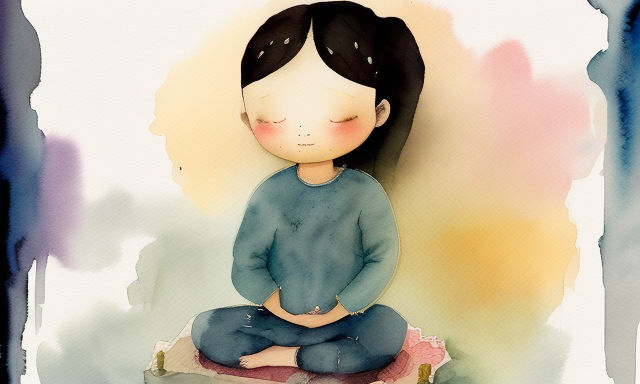What is Mindfulness Intention?
Setting an intention is a powerful practice for achieving success. Setting an intention involves being aware of where you are now, where you want to be, and what you want to do in the future. Developing a vision and being present in the moment help you create and manifest your vision. Developing a vision is an important step toward setting an intention.

Self-compassion
Self-compassion is an important coping strategy, especially when we feel insufficient, anxious, or have failed in some way. By cultivating self-kindness, we can avoid negative thoughts and feelings, bolster our confidence, and lessen our anxiety and stress. Self-compassion has been operationalized by Dr. Kristin Neff, who first described and operationalized the concept. The practice involves cultivating a sense of common humanity, as well as compassion for one’s own suffering.
Writing a letter expressing one’s feelings is a common exercise that helps develop self-compassion. It can help alleviate negative thoughts and feelings related to the tendency to rumination. While this practice may feel strange at first, it can help us develop our sense of compassion for ourselves. It can also help us learn how to be kinder to others. This activity is not just about expressing how we feel, but it can help us develop the ability to understand the feelings of others and appreciate their good intentions.
Self-compassion can help us cope with life’s toughest moments by focusing on ourselves instead of the problem. This practice teaches us to focus on our experiences instead of our perceived shortcomings and weaknesses. By focusing on the present moment and on the person experiencing the experience, we can transform our experience and redirect negative thoughts. While focusing on ourselves, we can also practice compassion for others, even when they may be at fault.
To help develop self-compassion, we need to explore and practice the practice. A self-compassion test will determine how far we are on the path to cultivating self-compassion. Self-compassion exercises, guided meditations, and other methods will help us improve our compassion. In addition, practicing self-compassion regularly is beneficial for the practice of mindfulness. It will help us develop the skills necessary to foster self-compassion in others and for ourselves.
Another study examined the relationship between gender and self-compassion. Researchers asked participants to rate their gender identity and whether they identified as feminine or masculine. Participants who strongly identified as masculine were significantly more self-compassionate than those who firmly identified as feminine. Self-compassion was highest among participants who self-identified as both masculine and feminine. Interestingly, socialization plays a large role in a person’s gender identity.
Identifying your values
If you’ve struggled to cultivate mindfulness and pay attention over the long term, you’ve probably already tried writing down your values. The act of writing down your values will help you make them concrete and remember them. Identifying your values will also help you avoid being draining by people-pleasing. The next step is to write down these values in a notebook or journal. As you continue to write, add new insights to the list.
Identifying your values is a crucial part of setting a mindful intention. Your values reflect your basic understanding of what matters in life. They are formed by your cultural upbringing, familial conditioning, and your own experiences. The values you hold dear may be situational, temporal, hierarchical, or subjective. The more mature you are, the more likely you are to adopt a core set of values that guide your life. This list may include several core values, or just a few of them.
Once you’ve identified your values, you’re likely wondering how to put them into action. Living by your values means being the most authentic version of yourself in all areas of your life. For each core value, choose one action that will help you embody the values. Then, repeat these actions daily. You’ll soon notice the difference it makes in your life.
When you’re unsure of how to get started with your practice, identify your champion within your organization. It will help you create the space and time necessary to make mindfulness part of the organization’s culture. If your champion isn’t part of your mindfulness group, create special outreach or an assessment to get their support. During the assessment, be sure to include the research that shows mindfulness increases employee well-being.
Setting positive intentions
For the sake of mindfulness, setting positive intentions is an excellent way to begin each day. These intentions should feel true to your body, heart, and gut. These feelings will give you a sense of inner direction and will prevent you from succumbing to self-doubt and criticism. This type of practice can be part of a daily meditation, journaling, or any other activity that can be done without interruption. But you must remember to stay consistent and nurture these intentions every day.
Intentions can be simple, big, or something in between. Whatever you choose, be sure to express them with conviction and from a centered place. For example, if you want to focus on your mindfulness practice, say your intention out loud in the morning. You can even incorporate it into your morning routine. While you are reading the newspaper or brewing your morning coffee, state your intention while pouring it. The more intentional you are, the more likely you are to succeed in achieving it.
You can also set future intentions. Intentions are about specific thoughts and desires. They can be as specific as you want them to be, and they can be as general as being kind to others. Other positive intentions include peace, freedom, community, and courage. You can choose whatever you feel will help you achieve your goals and intention. Once you set an intention, you will have the opportunity to measure it over time to see if you are on track.
Whether you practice mindfulness through meditation or yoga, the goal is to cultivate a practice that connects mind and body. When you do, try to focus on the body. A yoga instructor might suggest that you practice on your own. Instead of trying to compare yourself to others, listen to your body, and think about what you want from your practice. These suggestions might help you cultivate your mindfulness practice. And as long as you can stay focused, setting intentions can lead to real, lasting change.
The next step in setting your intention is to transition before you begin your meditation session. During this transition, think about engaging all of your senses. You can also read an ancient text or journal a quote. You can also sit in silence to meditate for a few minutes. Ultimately, setting positive intentions for mindfulness is a great way to practice mindfulness. Once you do, you will be more successful and efficient. There are many benefits to this approach, and you will soon see how powerful it can be.
Creating a Sankalpa
The basic practice of creating a sankalpa is planting your intention in the mind. The most basic way to do this is by repeating the intention three times before each meal. You can also repeat it at the end of a yoga practice, as this is a great time to refocus energy. Once you’ve planted your intention, the next step is to reinforce it.
To determine what sankalpa you should create, go through the Four Desires process. Using the Four Desires process, you can identify the behaviors that are not serving you. Examples include constantly checking your phone, eating unhealthy food, or engaging in addictive behaviors. In addition to unhealthy behaviors, you can consider your own feelings related to your sankalpa.
Creating a sankalp is a practice that involves listening. You must listen to what your heart desires, and acknowledge that you already have it. You must also acknowledge that the desire is based on a feeling of self-worth and does not originate from an outside source. By cultivating self-respect, you will be able to recognize the desire without allowing it to dominate your mind or body.
Once you have created your sankalpa, you will have a clearer focus and power to make your goal a reality. This practice is best done in a meditative state, especially yoga nidra. The sankalpa is a formal statement aligned with truth and dharma. It’s also a useful practice in many forms of mindfulness, including meditation and physical exercise.
You can create a sankalpa before beginning or ending Yoga Nidra Meditation. A sankalpa can guide you and help you plant seeds of your intention in this relaxed state. Creating a sankalpa can awaken your willpower and unite conscious awareness with unconscious forces. Intuition and visualization are key components in creating a sankalpa.





